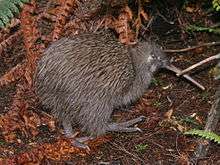New Zealand bittern
| New Zealand bittern | |
|---|---|
 | |
| New Zealand bittern (adult and juvenile males) | |
| Scientific classification | |
| Kingdom: | Animalia |
| Phylum: | Chordata |
| Class: | Aves |
| Order: | Pelecaniformes |
| Family: | Ardeidae |
| Genus: | Ixobrychus |
| Species: | I. novaezelandiae |
| Binomial name | |
| Ixobrychus novaezelandiae (A. C. Purdie, 1871) | |
| Synonyms | |
|
Ardea pusilla Vieill, 1817
| |
The New Zealand bittern (Ixobrychus novaezelandiae) is an extinct and enigmatic species of heron in the family Ardeidae. It was endemic to New Zealand and was last recorded alive in the 1890s.[2]
Common names for this species include New Zealand little bittern, spotted heron, and kaoriki (Maori).[3] The scientific species name also has numerous junior synonyms.[3]
Taxonomy
The species has sometimes been regarded as a subspecies of little bittern (Ixobrychus minutus), or conspecific with the black-backed bittern of Australia and New Guinea, though it was first described by Alexander Callender Purdie[2] in 1871 as Ardeola Novae Zelandiae.[4][5] In 1980 New Zealand palaeontologist Peter L. Horn found subfossil bones of a bittern from Lake Poukawa which he named Dupetor flavicollis. In 1991 Philip Millener identified Horn's material as remains of the New Zealand bittern.[6]
Description
Although a small bittern, the species was larger (length about 14.75 inches (38 cm)[5]) than the little bittern (25–36 cm). Few specimens are known, and of these there is even doubt about the sex of some, making published descriptions unreliable. Differences from the little bittern include a larger buff patch on the upperwing, black upperparts streaked light brown, underparts streaked dark brown and rufous-buff.[7]
Distribution and habitat
In recent times the bird is only known with certainty to have inhabited the South Island of New Zealand, with most records from Westland. Although subfossil remains have been found in the North Island, reports of living birds may have been of misidentified Australasian bitterns. The first scientific specimen was reportedly obtained at Tauranga in the North Island by a Reverend Mr Stack in 1836, but is now untraceable. The holotype specimen in the Museum of New Zealand was taken from the head of Lake Wakatipu in Otago.[8] The recorded habitat for the species includes the wooded margins of saline lagoons and creeks.[7][9]
Behaviour
Walter Buller quotes a Mr Docherty, who was familiar with the bird in Westland:
They are to be found on the salt-water lagoons on the seashore, always hugging the timbered side of the same. I have seen them in two positions, viz.:— standing on the bank of the lagoon, with their heads bent forward, studiously watching the water; at other times I have seen them standing straight up, almost perpendicular; I should say this is the proper position for the bird to be placed in when stuffed. When speaking of lagoons as the places where they are to be found, I may mention that I caught one about two miles in the bush, on the bank of a creek; but the creek led to a lagoon. They live on small fishes or the roots of reeds; I should say the latter, because at the very place where I caught one I observed the reeds turned up and the roots gone. They are very solitary, and always found alone, and they stand for hours in one place. I heard a person say that he had opened one and found a large egg in it. They breed on the ground in very obscure places; I never heard their cry.[10]
Feeding
The bittern is recorded as eating mudfish and worms in captivity, when given in water.[9]
Voice
Two calls were recorded by Buller, a "peculiar snapping cry" as an alarm call, and a "cry not unlike that of a kingfisher, though not so loud".[7]
References
Notes
- ↑ BirdLife International (2012). "Ixobrychus novaezelandiae". IUCN Red List of Threatened Species. Version 2013.2. International Union for Conservation of Nature. Retrieved 26 November 2013.
- 1 2 Tennyson & Martinson.
- 1 2 Walter Lawry Buller (1888). A history of the birds of New Zealand. pp. 136–138.
- ↑ Potts.
- 1 2 Purdie
- ↑ Worthy & Holdaway
- 1 2 3 Marchant & Higgins.
- ↑ "Ixobrychus novaezelandiae; holotype". Collections Online. Museum of New Zealand Te Papa Tongarewa. Retrieved 16 July 2010.
- 1 2 Oliver.
- ↑ Buller.
Cited texts
- Buller, Walter Lowry (1888). A History of the Birds of New Zealand. Made available through the New Zealand Electronic Text Centre. pp. 137–138.
- Marchant, S.; Higgins, P.J., eds. (1991). Handbook of Australian, New Zealand and Antarctic Birds. Volume 1: Ratites to Ducks. Melbourne: Oxford University Press. pp. 1045–1046. ISBN 0-19-553244-9.
- Oliver, W.R.B. (1955). New Zealand Birds (2nd ed.). Wellington: Reed. pp. 397–398.
- Potts, T.H. (1871). "On the Birds of New Zealand (Part II)". Transactions of the New Zealand Institute. 3: 59–109.
- Purdie, A.C. (1871). "On a (supposed) new species of Bittern from the Lake District". Proceedings of the New Zealand Institute. 3: 99–100.
- Tennyson, A. & Martinson, P. (2006). Extinct birds of New Zealand. Wellington: Te Papa Press. pp. 40–41. ISBN 0-909010-21-8.
- Worthy, T. H. & Holdaway, R. N. (2002). The lost world of the moa: prehistoric life of New Zealand. Indiana University Press. p. 244. ISBN 978-0-253-34034-4.
External links
- Holotype from the collection of the Museum of New Zealand Te Papa Tongarewa
- New Zealand Little Bittern / Kaoriki. Ixobrychus novaezelandiae. by Paul Martinson. Artwork produced for the book Extinct Birds of New Zealand by Alan Tennyson, Te Papa Press, Wellington, 2006
| Wikispecies has information related to: Ixobrychus novaezelandiae |

